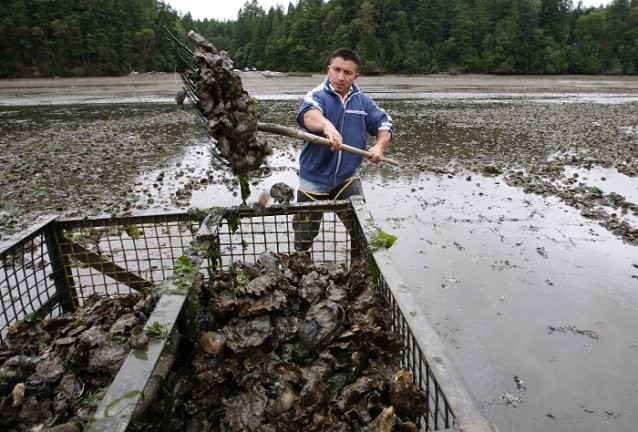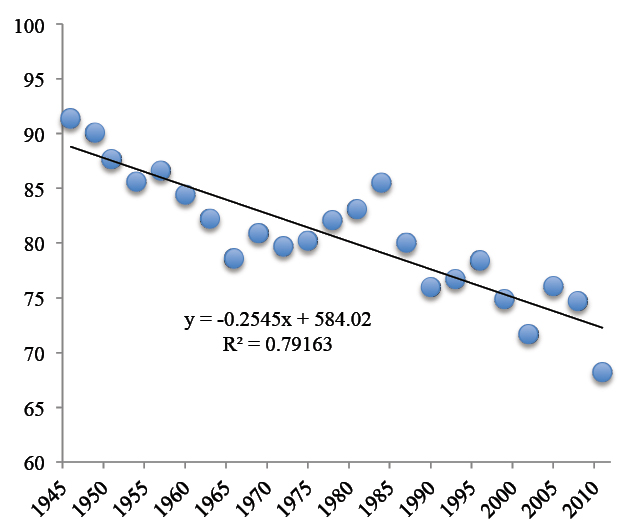After 26 years of climate inaction pull plug on IPCC

Al and the Pussycat: Despite founding Wikipedia, the internet’s sixth most popular website, Jimmy Wales makes no money out of his creation. But while the anybody-may-edit model employed by the encyclopedia has proved surprisingly successful, articles published by a climate action wiki would need to be peer-reviewed for it to have sufficient authority to be relied upon by governmental bodies. image Bill Waugh Associated Press
It is unstoppable, and it has possibly doubled. And while that is only the disintegration of the Western Antarctic Ice Sheet, the same is probably true for global warming generally.
Three years of the most detailed satellite measurements yet, to the end of last year, show the Antarctic to be losing 159 billion tonnes of ice each year, twice that measured, albeit at a lower resolution, between 2005 and 2010. This volume is raising the sea level by 0.45 millimetre per year, hard-chasing Greenland’s 1-millimetre annual contribution, which has similarly doubled over a similar timeframe.
That the acceleration of Thwaites Glacier was news twice last week with the publication of two new reports was no surprise to those who have been following the fate of neighbouring Pine Island Glacier. But if subsequent measurements from the same new satellite, CryoSat-2, confirms a doubling time of anything close to four years, folks can safely put their copies of the Intergovernmental Panel on Climate Change’s latest summaries for policymakers out with the recycling now.
With the science on anthropogenic global warming unfolding ever-rapidly, policymakers and the public alike need a definitive portal through which to retrieve up-to-the-minute information on which to base decisions, including which political party to take seriously. Peer-reviewed articles pertaining to global warming are being published at the rate of six per day. No individual climate expert, much less decision-maker or newspaper editor, can hope to keep abreast of this avalanche of evidence. But not only is that an almost impossible requirement, there is a lag between when the scientific data is collected, or phenomena observed, and when it is published. After collection or observation comes the analysis, the writing, and the back-and-forth of peer review. Only then is the work considered for publication.
Some data, of course, can be published as a matter of course, such as that which continues the Keeling Curve skyrocketing into uncharted territory. Data documenting the Arctic Sea Ice death spiral is also available for publication month by month. Humanity so far appears to be strangely unmoved by this spectacular event—unprecedented not only in the history of civilisation, but possibly in the last million years. But as well as being profoundly important to polar bears, the advent of sea-ice-free summers will herald a slew of mutually reinforcing climate feedbacks. For those who missed the biggest story of 2013, which thanks to a science-challenged mainstream media is most people, extremely high concentrations of that 86-times-more-potent greenhouse gas than carbon dioxide, methane, is already escaping from hydrates in the shallow Arctic seabed. These will probably increase spectacularly, and potentially unstoppably. Humanity in the 2010s has a front-row seat, but appears to be more interested in its bucket of popcorn. Only with the benefit of hindsight will it be known when these feedbacks became runaway global warming, or fitted one or other less-extreme definition of the term—Shakhova et al.:
…we consider release of up to 50 Gt of predicted amount of hydrate storage as highly possible for abrupt release at any time. That may cause ~12-times increase of modern atmospheric methane burden with consequent catastrophic greenhouse warming.
Once the wild mutually-reinforcing-feedback ride becomes alarmingly unmistakable, governments of the world will leapfrog from their current platitudes about the need to reduce greenhouse gas emissions to global climate action in the form of desperate geoengineering—the window available in which to radically decarbonise energy having been completely squandered.
In this escalating global emergency, governments and local authorities have an urgent need for authoritative up-to-the-minute analysis and assessments of the latest climate data and publications. This, surely, must take the form a climate-action wiki, mediated by a permanent staff, employed by a new global climate action agency, and that agency should answer to a new and robustly democratic global parliamentary assembly. Ideally, this would be facilitated by the United Nations, but that institution has long-resisted the metamorphosis envisaged by its original proponents. While the need for radical action to reduce greenhouse gas emissions should have provided a more than sufficient spur for its reform, the spectre of a superpower launching a global geoengineering pre-emptive ‘first strike’, in response to runaway global warming, will be the ultimate test for the United Nations, which turns 70 in October next year.
Meanwhile, an Intergovernmental Panel on Climate Change wiki has been established, by economist Richard Tol, who famously emphasised what he claimed will be the upside of anthropogenic global warming of 2–4°. With a little help from his friends, he plans to upload the entire Fifth Assessment Report, and to allow more recent data and publications to be added. While that is exactly what is needed to bring the report up to date, the wiki is to be self-moderated, in the manner of Wikipedia, which will mean that quoting Dr Tol’s wiki will carry no more weight that quoting Wikipedia. This is not to denigrate Wikipedia, it is an indispensable repository, as Tol’s wiki may well become. But unmoderated, it can never become the authoritative last word on climate action that is so desperately needed. The intergovernmental panel needs to respond immediately with a wiki that it holds in trust until a globally elected body can assume responsibility for it.
Just as few people are silly enough to brag about reading the likes of Encyclopedia Britannica ‘cover to cover’, few will attempt to read the 9000-page Fifth Assessment Report right through. However, at 30-odd pages each, many may be tempted to read the summaries ‘for Policymakers’. That temptation should be resisted. As a guide for governments, or anybody else, these and previous summaries are not fit for purpose. Even taking into account the often-considerable extent to which the assessments upon which they are based are out of date, every line, line-by-line, that survives in the summaries has been worked over by non-expert government appointed delegates. Nothing that offends countries such as the oil-rich Saudis gets to see the light of day—entire inconvenient lines are deleted. Yet Summary for Policymakers material is that most likely to be quoted by governments and local councils to justify their action, or more often, inaction on global warming. University of Oxford philosophy professor and climate specialist John Broome describes the Working Group 3 Summary for Policymakers process ‘At the IPCC’:
Late on Wednesday evening, during a brief break, the delegates formed a huddle in the corner, trying to agree text between themselves. We, who would be named as authors of the final product, were left as spectators.

Evil Twins Kills 10 Million: Ocean acidification is being called the ‘Evil Twin’ of global warming, but of course warming and ocean acidification are both the result of anthropogenic greenhouse gas emissions, and are equal in their evilness. And while it is the death of 10 million scallops that has recently hit the headlines, ocean acidification is also impacting the Pacific Northwest’s oyster farmers. image Ted S Warren Associated Press
The somewhat more reliable summaries, of the three working groups, are those each titled Technical Summary. They range from 76 to 115 pages, but are only slightly more technical than the adulterated ‘policymakers’ documents. But after 26 years and 5 consecutive—though, famously conservative—assessment reports totalling 18 500-odd pages, there has been no meaningful climate action taken, and in that time the volume of carbon dioxide emitted from fossil fuels has soared from 21 to 36 billion tonnes annually. Mankind, then, still has its metaphorical pedal to the metal. Progress is pleasing, and self-absorbing to the extent that the odd speed advisory sign has flashed by unnoticed. But despite the kids in the back beginning to sound alarmed, the driver has never had a bad accident and is confident of his abilities. Suddenly the road begins to descend steeply, only for the driver to discover the accelerator stuck down. Standing on the brake pedal, it goes straight to the floor—a case of catastrophic brake-line failure. Speed builds rapidly, and the first sharp bend is rapidly approaching. The handbrake works momentarily, and then not at all. The kids are screaming ‘Turn the key off! Turn the key off!’, but panic has set in, and fear of locking the steering column overrides all rational thought.
While global warming is irreversible in human timeframes, its acceleration can be checked, by radically reducing anthropogenic greenhouse gas emissions—turning off the ignition. But only by extracting carbon dioxide from the atmosphere, which would be incredibly expensive, or by reflecting away some of the sun’s incoming radiation, which would be incredibly risky, can the warming be reversed—not that that will save the Western Antarctic Ice Sheet. Meantime, the 0.8° warming already in place is 0.8° too much for those living at sea level, and the accompanying 26% ocean acidification is already too much for the scallop farmers who lost 10 million scallops last year.

National Going Down: With voter turnout in 2011 the lowest in 120 years, the National Party came perilously close to losing the election. Three years on, it is the new Internet Mana Party, dedicated to stopping National, that will succeed in mobilising a significant number of the 31.8% who failed to vote last time. chart Jack Vowles Victoria University of Wellington
Once the Internet Mana Party is registered, New Zealanders will have a total of 15 parties from which to choose in September’s election. Bizarrely, despite it being the moral issue of the millennium, not one party has nailed its colours to the climate action mast, such is the fear of repelling the electorally significant minority who still deny global warming and/or that it is anthropogenic—19.3% and 32.7% respectively, in 2011. Politicians in the United States keen to be seen to be doing something about acidification go to spectacular lengths to avoid mentioning its scientifically undisputed cause. A 3381-word report on the website of Maria Cantwell, Democratic senator for the State of Washington, titled ‘Cantwell: Key Fishery Bill Should Tackle the Threat of Ocean Acidification’, mentions neither carbon, climate, fossil, greenhouse nor warming.
Back in Aotearoa, the Internet Mana Party provides the best opportunity to deny National the opportunity to continue its climate wrecking, ocean-acidifying policies. A key part of the Internet Mana Party’s strategy is to mount a ‘Get out the vote’ campaign targeting young, Māori, and Pasifika voters. This is likely to be a game changer, given the likelihood, otherwise, of turnout worse than that in 2011, of 68.2%—many of the missing 31.8% are indeed young, Māori, and Pasifika.
Though the young of today’s young, Māori, and Pasifika will wonder why on Earth, back in 2014, it wasn’t the Climate Internet Mana Party, a post-September coalition made possible by the new Internet Mana Party is the best prospect, to date, for meaningful climate action.
Update Three days after the publication of this piece, the Green Party announced a substantive climate action policy, a carbon tax à la Dr James Hansen. If the party could now scrape together the courage to confront its ideological abhorrence of nuclear power…
Plug Pulled on Western Antarctic: The European Space Agency’s environmental research satellite, since 2010, has provided data on ice cap thickness changes to a resolution of about 13 millimetres that indicates a doubling of ice loss within a 4-year period. This could well lead to rapid sea-level rise pulses, such as those observed the end of the last glaciation. Video National Aeronautics and Space Administration
Straight Up: The familiar gently upward-sloping Keeling Curve looks very different when viewed from a 800 000-year perspective. And while what goes up generally comes back down, the paleoclimate record is one of near-vertical spikes, followed by prolonged descents. Video Cooperative Institute for Research in Environmental Sciences – National Oceanic and Atmospheric Administration

I agree. The hook up between Mana and Internet means there won’t be 5% threshold issues and the votes go left. Harre will be an asset. It may be enough to dislodge the Key party.
The last time the world had today’s level of 400 part per million of CO2 was four million years ago and the trees and plants at that time were adapted to the climate that went with it. Those trees had taken thousands or years to evolve to match those conditions. The trees we have today are adapted to a CO2 level of 280 PPM and a climate 0.8C cooler than today and are rapidly going into conditions 2C warmer and with dramatically changed rainfall conditions of either drought or flood. We can expect to see much large numbers of trees and other plant life dying in the coming years.